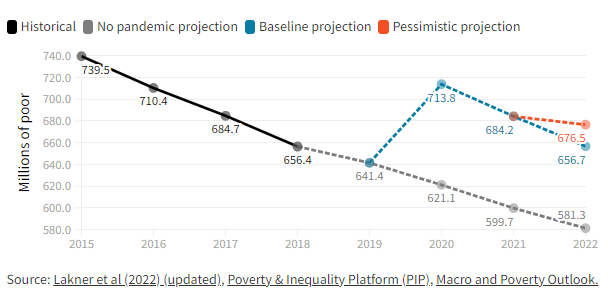Context
October 17, is celebrated as International Day for the Eradication of Poverty as designated by United Nations. This article deals with the relevance of the day and India’s status on the poverty.
About
- The International Day for the Eradication of Poverty is observed every year on October 17th. Its purpose is to foster understanding and dialog between individuals experiencing poverty and the broader society.
- It promotes dialogue and understanding between people living in poverty and their communities, and society at large. “It represents an opportunity to acknowledge the efforts and struggles of people living in poverty, a chance for them to make their concerns heard and a moment to recognise that poor people are in the forefront in the fight against poverty.”
Theme of the Day
“Decent Work and Social Protection: Putting Dignity in Practice for All.”
- This year’s theme highlights the personal experiences of individuals who are trapped in extreme poverty and are forced to work long and exhausting hours in hazardous and unregulated environments. Despite their efforts, they are unable to earn sufficient income to adequately support themselves and their families.
- Additionally, the theme also advocates for the universal availability of fair employment opportunities and social safeguards in order to uphold the dignity of all individuals.
- It emphasizes that decent work should empower people, offer equitable wages and safe working conditions, and fundamentally acknowledge the intrinsic value and humanity of all workers.
Background
- The International Day for the Eradication of Poverty first commemoration, “World Day to Overcome Poverty” took place in Paris, France, in 1987.
- When lakhs of people gathered on the Human Rights and Liberties Plaza to honour the victims of poverty, hunger, violence, and fear.
- In 1992, the United Nations designated October 17 as the International Day for the Eradication of Poverty.
Why do we mark International Days?
- International Day for the Eradication of Poverty celebrate to educate the public on issues of concern, to mobilize political will and resources to address global poverty, and to celebrate and reinforce achievements of humanity.
Facts & Figures
Global Scenario
The global poverty lines estimates for early 2022 were determined based on the poverty line of US$1.90 per person per day. In September 2022, the World Bank revised the global poverty lines to US$2.5 per person per day.

Indian Scenario
- In September 2023, the unemployment rate in India decreased to 7. 1% from 8.1 % in August, as reported by the Centre for Monitoring of Indian Economy (CMIE).
- According to the Periodic Labor Force Survey Annual Report 2022-2023 released by the National Sample Survey Office, India’s unemployment rate for individuals aged 15 years and older reached a six-year low of 3.2 % from July 2022 to June 2023.
- The Worker Population Ratio (WPR) throughout urban areas in India increased from 43.9 % in April-June 2022 to 45.5% in April-June 2023 for individuals aged 15 years and older.
- During this period, the WPR for males rose from 68.3 % to 69. 2%, while for females, it increased from 18.9 % to 21.1%.
Poverty and Related Issues
- In today’s world, marked by remarkable economic progress, advanced technology, and abundant financial resources, it is morally unacceptable that millions of individuals are trapped in extreme poverty.
- Poverty is not just an economic problem; it is a complex issue that involves not only a lack of income but also a deprivation of the fundamental capabilities necessary for a life of dignity.
- Those living in poverty face a multitude of interconnected and mutually reinforcing disadvantages, which hinder them from exercising their rights and perpetuate their impoverished conditions. These deprivations include:
- Dangerous work conditions
- Unsafe housing
- Lack of nutritious food
- Unequal access to justice
- Lack of political power
- Limited access to health care
United Nations: – Accelerating global actions for a world without poverty
- In resolution 72/233, the General Assembly officially declared the start of the Third United Nations Decade for the Eradication of Poverty (2018–2027).
- The Assembly also acknowledged that the theme of the Third Decade, should focus on “Accelerating global actions for a world without poverty,” aligning with the goals outlined in the 2030 Agenda for Sustainable Development.
- This report primarily presents a comprehensive plan of action to effectively eradicate poverty.
Goal 1: End poverty in all its forms everywhere

Poverty elevation schemes in India
- Integrated Rural Development Program (IRDP):
- It was introduced in 1978-79 and was made universally available from 2nd October, 1980.
- Its objective was to assist the rural poor by providing subsidies and bank credit for productive employment opportunities during successive plan periods.
- Jawahar Rozgar Yojana/Jawahar Gram Samridhi Yojana (JRY):
- It aimed to create meaningful employment opportunities for unemployed and underemployed individuals in rural areas.
- This was achieved by developing economic infrastructure and community and social assets.
- Rural Housing – Indira Awaas Yojana (LAY) program
- It had the goal of providing free housing to families below the poverty line (BPL) in rural areas, with a particular focus on households belonging to SC/ST communities.
- Mahatma Gandhi National Rural Employment Guarantee Act (MGNREGA) (2005)
- It ensures that every rural household is guaranteed 100 days of employment each year. One-third of the available jobs will be set aside for women.
- In the event that an applicant is not provided with employment within 15 days, they will be eligible to receive a daily unemployment allowance.
- Aajeevika – Deendayal Antyodaya Yojna-National Rural Livelihoods Mission (DAY-NRLM):
- It was launched by the Ministry of Rural Development (MoRD), Government of India, in June 2011. With support from the World Bank, the mission’s goal is to establish reliable and productive institutional platforms for the rural poor.
- This will enable them to enhance their household income through sustainable livelihood opportunities and better access to financial services.
- National Urban Livelihood Mission (2013):
- This program concentrates on mobilizing urban individuals with limited resources into Self Help Groups. It also provides opportunities for skill development, leading to employment in the market.
- Additionally, it supports the establishment of self-employment ventures by ensuring convenient access to credit.
- Pradhan Mantri Ujjwala Yojana (PMUY) (2016):
- This initiative was introduced to provide 50 million LPG (liquefied petroleum gas) connections to women belonging to Below Poverty Line (BPL) families.
- Task Force on Elimination of Poverty in India:
- It was established on March 16, 2015, under NITI Aayog. The main focus of the Task Force’s report is on addressing the measurement of poverty and developing strategies to combat it.
- Additionally, the Task Force has provided recommendations on achieving faster poverty reduction through employment-intensive sustained rapid growth and the effective implementation of anti-poverty programs.
- As per NITI Aayog’s Report ‘National Multidimensional Poverty Index: A Progress Review 2023’, A record 13.5 crore people moved out of multidimensional poverty between 2015-16 and 2019-21
- According to the UN’s Global Multidimensional Poverty Index-2018, India has witnessed a significant improvement in poverty reduction.
- Between 2005-06 and 2015-16, approximately 271 million individuals have successfully escaped poverty. This positive trend has led to a notable decline in the poverty rate, which has almost halved from 55% to 28% over the span of ten years.
- However, it is important to acknowledge that a considerable portion of the Indian population still resides below the Poverty Line.
Thus, Initiatives such as Saubhagya, Pradhan Mantri Awas Yojana (PMAY), Pradhan Mantri Jan Dhan Yojana (PMJDY), and Samagra Shiksha have played a significant role in reducing multidimensional poverty in the country. The government’s commitment to improving citizens’ lives and creating a better future for all is evident in the remarkable progress made in achieving low deprivation rates for electricity, access to bank accounts, and drinking water.
The successful implementation of various programs and initiatives, which are interconnected, has led to a substantial decrease in deprivations across multiple indicators.









